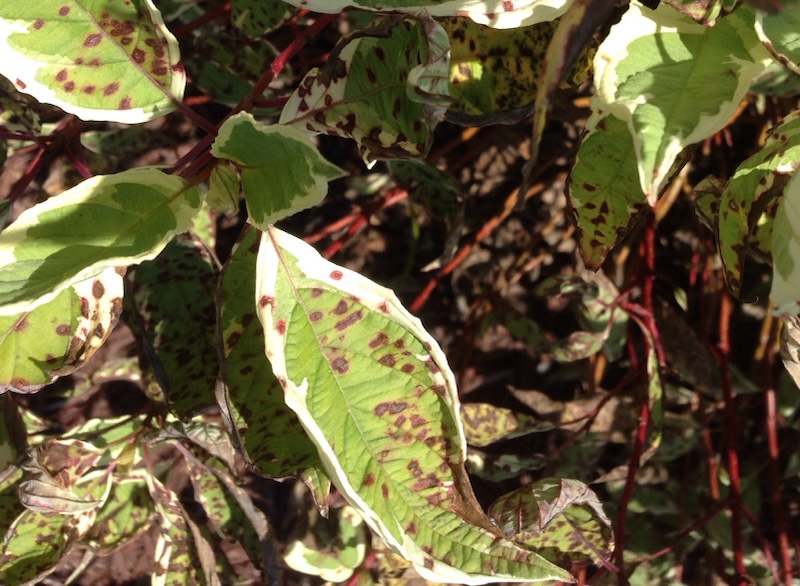Dogwoods are grown for their striking good looks, and anything that compromises the plant’s appearance and health is concerning. Several diseases impact dogwood trees and can cause undue stress on the plant, potentially resulting in the tree's death. Most common dogwood diseases are fungal, and are treatable and preventable. Anthracnose, powdery mildew, and leaf spots are the most common dogwood diseases.

Photo by Tim Evanson, cropped, Flickr, Copyright CC BY-SA 2.0 DEED
Dogwood Spot Anthracnose
Anthracnose is a fungal infection common in flowering dogwoods. Wet spring weather is conducive to anthracnose. Increased humidity and damp conditions promote the spread. The fungus that causes anthracnose can live on the plant throughout the winter, so once a dogwood is infected, the fungus will return unless adequately treated.
Identifying Spot Anthracnose
Anthracnose appears as tiny tan-colored spots with purplish-red borders. The infected sites will merge as the infection spreads, creating large patches of dead growth. Infected flowers and leaves may have a deformed appearance. Flowers are often the first part of a dogwood to show spots, followed by leaves and new growth. A single anthracnose infection will cause minimal damage to a dogwood, but continued outbreaks will weaken the plant, stunt growth, and potentially kill the plant.

Photo by Mary Ann Hansen, Virginia Polytechnic Institute and State University, Bugwood.org., unedited, Flickr, Copyright CC BY 2.0 DEED
Treating Spot Anthracnose
Treat dogwood anthracnose by removing infected flowers and foliage. Treat the plant with a fungicide and reapply the treatment every couple of weeks. Prune the plant to thin the vegetation, allowing for improved air circulation.
Dogwood Powdery Mildew
Powdery mildew is a fungal infection that targets various plants, including dogwood. Humid days and cool nights without adequate airflow create a welcoming atmosphere for this fungus. This fungal infection kills leaves and can spread throughout a plant. An infected dogwood may experience stunted growth; however the damage is typically cosmetic only. Powdery mildew is preventable and will return unless proper measures are taken.
Identifying Powdery Mildew
Powdery mildew is a whitish-gray mildew covering an infected leaf's entire surface. The mildew has a powder-like texture and almost looks fuzzy. Dead spots will develop on infected leaves, and the whole leaf will wilt as the infection spreads.

Photo by Jim Allen
Treating Powdery Mildew
Treat powdery mildew on dogwood by removing infected foliage. Trim leaves and burn them or dispose of them in the trash, to prevent further spread of this fungus. Spray the plant with a fungicide to further treat the infection. Keep powdery mildew from returning by leaving plenty of space when planting dogwood shrubs so air can circulate around the leaves. Continue to water shrubs and trees throughout the summer, as a dehydrated plant is more susceptible to this fungus.
Dogwood Leaf Spots
A fungal infection causes dogwood leaf spots. Damp, humid weather brings on the spots that often appear in summer. The disease can quickly spread throughout a dogwood and to nearby trees. One year of leaf spots will not cause significant harm to a dogwood, but repeated years of early leaf drop will stunt growth and weaken the tree.
Identifying Leaf Spots
Irregular-shaped spots appear between the leaf veins. The spots have brown or purplish centers and yellow borders, depending on the specific fungus present. Infected leaves will drop.

Photo by Scot Nelson
Treating Leaf Spots
Prevent the spread of dogwood leaf spots by removing dropped infected leaves. Burn the leaves to kill the fungus or keep them away from other plants and out of a compost pile. Prune the tree to thin the canopy and allow for increased airflow. Spray an infected dogwood with a fungicide to treat the infection.
Dogwood Disease Chart
| Disease | Identifying | Treating |
|---|---|---|
| Spot Anthracnose | Tan spots | Prune branches |
| Powdery Mildew | Powdery white spots on leaves | Proper air circulation |
| Leaf Spots | Dark spots on leaves | Fungicides & air circulation |
Sources: "Dogwood Diseases and Insect Pests." Clemson University, Clemson Cooperative Extension. hgic.clemson.edu
 |
Author Alison Cotsonas - Published 01-12-2024 |
